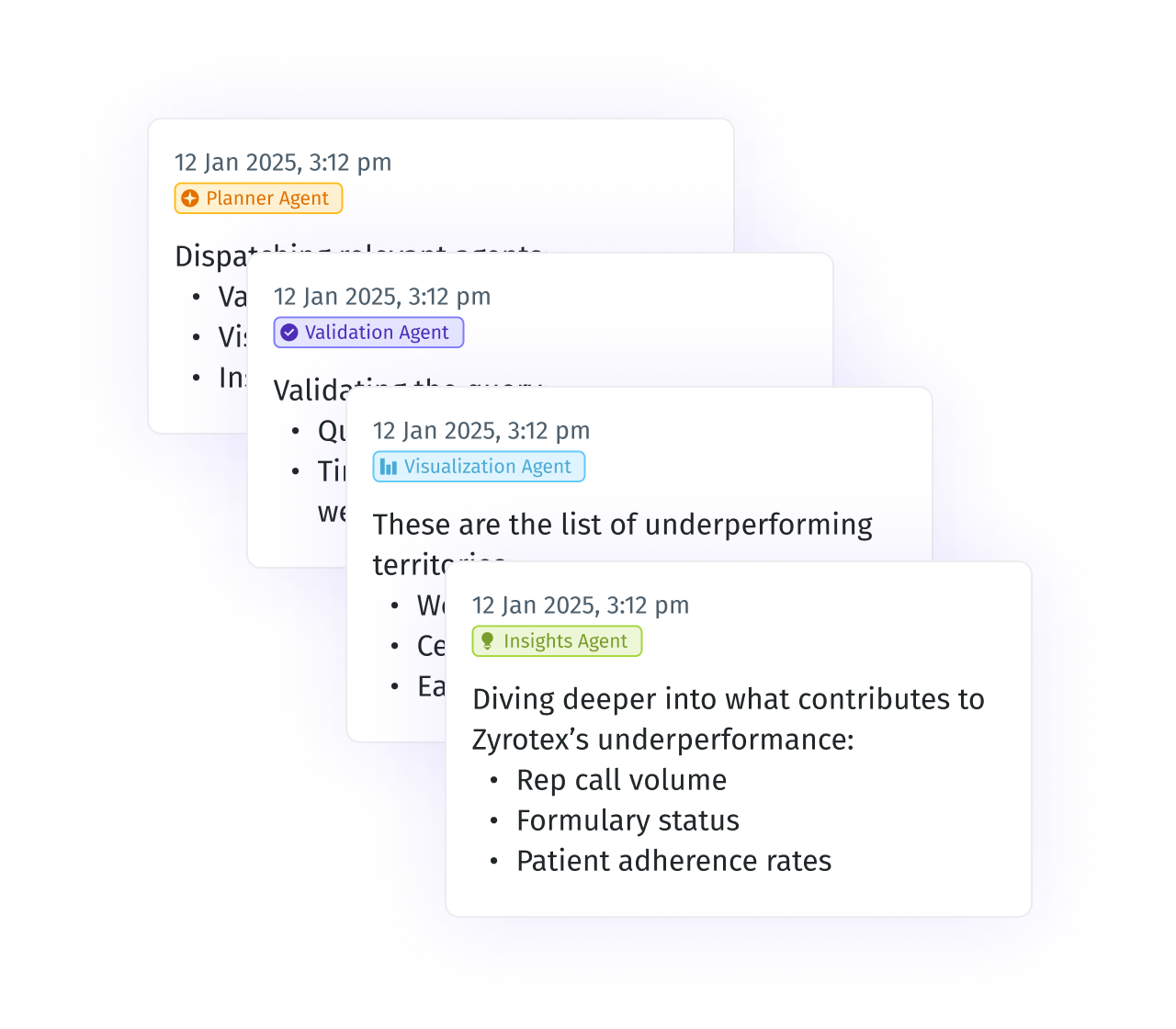Healthcare Analytics, Reimagined.
Accelerate data-driven decisions by unifying EHR, claims, and operational data—cut readmissions, optimize resources, and elevate the patient experience with conversational insights.

Insights Meet Action
Unify internal and external data, surface AI-powered insights, and turn confident, data-driven decisions into action—without complexity.
Break Data Silos, Unlock Healthcare Insights
Easily merge internal clinical, operational, and financial data with external sources—such as public health data. Uncover hidden opportunities, optimize care delivery strategies, and empower smarter, data-driven decisions across your healthcare organization

Instant Answers, Faster Results
Ask and answer any healthcare operational question in a self-service conversational manner, empowering every team to explore data, uncover insights, and make confident decisions—no SQL or analyst backlogs required.

Turn Complex Data into Clear Actions
Leverage advanced AI and dynamic storytelling to transform volumes of healthcare data into actionable insights. Tellius automatically surfaces key drivers, trends, and anomalies, translating complex analytics into concise narratives that support patient-centered care and operational efficiency

A Squad of Agents by Your Side -- 24/7
AI-powered agents leverage RAG and a robust Knowledge Layer to deliver real-time insights, automate complex analysis, and enhance decision-making across your healthcare ecosystem—instantly.

Use Cases
Optimize Predictive Staffing
Ensure the right staff is in the right place at the right time. Forecast staffing needs with precision to match patient volumes and improve operational efficiency.
Improve Patient Flow
Identify bottlenecks and optimize patient movement for seamless hospital operations.

Claims & Billing Analysis
Ensure compliance, identify underpayments, improve reimbursement rates , and rapidly uncover drivers to streamline billing workflows, reduce overhead, and boost revenue.
Cost & Performance Analytics
Pinpoint areas for cost reduction and performance improvement across departments, specialties, and service lines. ( e.g. improve patient care quality and save millions of dollars by identifying the true cost of procedures)

Reduce Hospital Readmissions
Identify root causes of readmissions and predict at-risk patients, then implement targeted interventions to improve outcomes and reduce penalties.
Improving Hospital-Acquired Conditions (HACs)
Identify risks, monitor outcomes, and ensure patient safety to meet quality standards.

Identifying High-Risk Patients
Predict at-risk populations and drive targeted interventions to improve care outcomes and reduce costs.
Personalized Outreach & Care
Segment patient populations by risk profile, health history, and demographic data to tailor preventive care and post-discharge follow-ups.


Transform Healthcare Analytics with AI-Driven Intelligence
Harness the power of AI to unify data, uncover critical insights, and drive smarter decisions across patient care, operations, and financial performance.

Turn Healthcare Insights into Actionable Impact
Unify clinical, operational, and financial data with AI-powered insights that drive real-world improvements in patient care, financial performance, and operational efficiency—turning complex data into smarter actions.

Unleash the full power of data
to insights

Breakthrough Ideas, Right at Your Fingertips
Dig into our latest guides, webinars, whitepapers, and best practices that help you leverage data for tangible, scalable results.

Introducing Tellius AI Agents

Tellius AI Agents and AgentComposer transform business analytics by automating complex multi-step analysis through specialized autonomous agents. Unlike generic chatbots or RPA tools, these agents leverage your enterprise data and business context to deliver deep insights across sales, marketing, finance, and manufacturing—turning questions into actions in minutes instead of days. With no-code agentic workflows, organizations can achieve 100X productivity gains and continuous, data-driven decision making.

AI Agents: Transforming Data Analytics Through Agentic AI

AI agents—intelligent software that perceives environments, makes decisions, and takes actions to achieve specific goals—are fundamentally reshaping how people interact with data and systems.

6 Gator-Sized Takeaways from the Gartner Data & Analytics Summit 2025

TLDR: agents on the rise, conversational everything, governance & data quality = king, driving/demonstrating ROI, the power of people never gets old.

Tellius 5.3: Beyond Q&A—Your Most Complex Business Questions Made Easy with AI

Skip the theoretical AI discussions. Get a practical look at what becomes possible when you move beyond basic natural language queries to true data conversations.

Tellius 5.2: Conversational AI for Analytics, Done Right

Tellius 5.2 introduces an adaptive conversational interface with feedback and learnings, enabling two-way dialogue with your cloud-scale data in natural language.

The Pelmorex AI-Driven Analytics Journey

Discover how AI analytics is revolutionizing data-driven decision-making at Pelmorex, a global leader in weather and climate analytics.
.png)
Tellius AI Agents: Driving Real Analysis, Action, + Enterprise Intelligence

Tellius AI Agents transform business intelligence with dedicated AI squads that automate complex analysis workflows without coding. Join our April 17th webinar to discover how these agents can 100x enterprise productivity by turning questions into actionable insights, adapting to your unique business processes, and driving decisions with trustworthy, explainable intelligence.

Snowflake Summit 2023

Tellius is a Green Circle sponsor at Snowflake Summit 2023. Hear how eBay is is taking self-service data exploration to the next level. Stop by Booth 1751 to win some great prizes.

